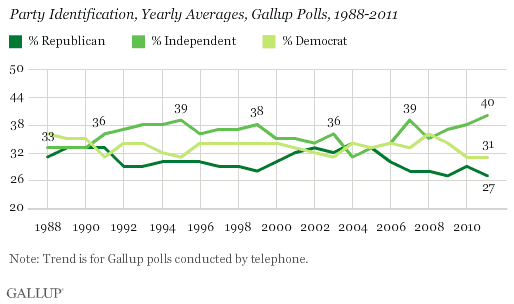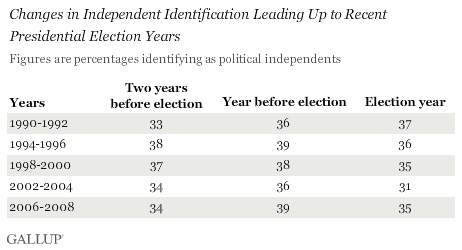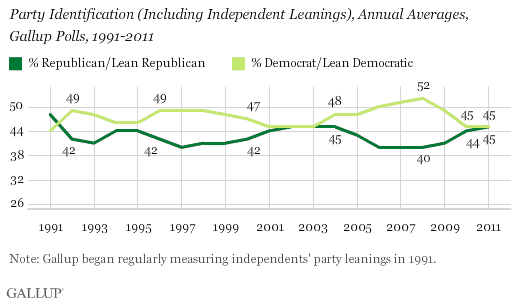PRINCETON, NJ -- The percentage of Americans identifying as political independents increased in 2011, as is common in a non-election year, although the 40% who did so is the highest Gallup has measured, by one percentage point. More Americans continue to identify as Democrats than as Republicans, 31% to 27%.

These results are based on more than 20,000 interviews conducted in 20 separate Gallup polls in 2011. Gallup has computed annual averages of party identification since 1988, when it began regularly conducting interviews by telephone. The prior high percentage of independents was 39% in 1995 and 2007.
Gallup records from 1951-1988 -- based on face-to-face interviewing -- indicate that the percentage of independents was generally in the low 30% range during those years, suggesting that the proportion of independents in 2011 was the largest in at least 60 years.
In recent decades, Gallup has observed a pattern of increased independent identification in the year prior to a presidential election, and a decline in the presidential election year. The only exception to that was in 1992, when independent identification increased from 1991, perhaps the result of President Bush's high approval ratings in 1991 and Ross Perot's independent presidential candidacy in 1992.

Thus, one would expect that fewer Americans will identify as independents in 2012 than in 2011.
Democrats Maintain Edge in Party Identification in 2011
There was a two-point increase in independent identification from 2010 (38%) to 2011 (40%). The increase in independent identification came at the expense of Republican identification, which dropped from 29% to 27%, while Democratic identification held steady at 31%.
The net result of those changes is an increase in the Democrats' advantage in party ID over Republicans, from two points to four points. However, that remains below the eight- (36% to 28%) and seven-point (34% to 27%) Democratic advantages in 2008 and 2009, respectively.
More Americans have identified as Democrats than Republicans in all but a few years since 1988.
Parties More Competitive in Leaned Party Identification
Despite the Democratic advantage in party identification, proportionately more American independents lean to the Republican Party than to the Democratic Party. Thus, when independents' party leanings are taken into account and combined with the party's core identifiers, the parties end up tied. In 2011, 45% of Americans identified as Republicans or leaned to the Republican Party and 45% identified as Democrats or leaned Democratic.
This is similar to 2010, when the Democrats had a 1-point advantage in leaned party identification, but remains well below the 12-point Democratic advantage in 2008 -- the largest Gallup has recorded for either party since it began regularly measuring leaned party identification in 1991.

Leaned party identification may give a better sense of the parties' electoral competitiveness, because independents with party leanings vote similarly to party identifiers. Thus, the parties are essentially on equal footing heading into the 2012 presidential election year. Democrats have held an advantage for most of the 21 years Gallup has tracked this measure.
Implications
Increased independent identification is not uncommon in the year before a presidential election year, but the sluggish economy, record levels of distrust in government, and unfavorable views of both parties helped to create an environment that fostered political independence more than in any other pre-election year.
As Americans' attention turns to choosing a president for the next four years and they line up behind President Obama or his Republican challenger, the percentage of independent identifiers is likely to fall this year. However, if national conditions and the political environment do not change appreciably over the course of this year, independent identification -- even if it declines -- will probably remain on the higher end of what Gallup has measured historically.
Survey Methods
Results for this Gallup poll are based on telephone interviews conducted January-December, 2011, with a random sample of 20,392 adults, aged 18 and older, living in all 50 U.S. states and the District of Columbia.
For results based on the total sample of national adults, one can say with 95% confidence that the maximum margin of sampling error is ±1 percentage point.
Interviews are conducted with respondents on landline telephones and cellular phones, with interviews conducted in Spanish for respondents who are primarily Spanish-speaking. Each sample includes a minimum quota of 400 cell phone respondents and 600 landline respondents per 1,000 national adults, with additional minimum quotas among landline respondents by region. Landline telephone numbers are chosen at random among listed telephone numbers. Cell phone numbers are selected using random-digit-dial methods. Landline respondents are chosen at random within each household on the basis of which member had the most recent birthday.
Samples are weighted by gender, age, race, Hispanic ethnicity, education, region, adults in the household, and phone status (cell phone only/landline only/both, cell phone mostly, and having an unlisted landline number). Demographic weighting targets are based on the March 2010 Current Population Survey figures for the aged 18 and older non-institutionalized population living in U.S. telephone households. All reported margins of sampling error include the computed design effects for weighting and sample design.
In addition to sampling error, question wording and practical difficulties in conducting surveys can introduce error or bias into the findings of public opinion polls.
For more details on Gallup's polling methodology, visit www.gallup.com.
